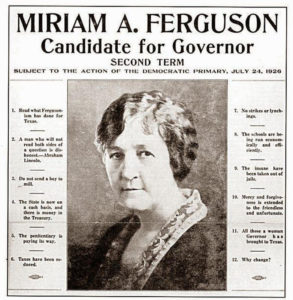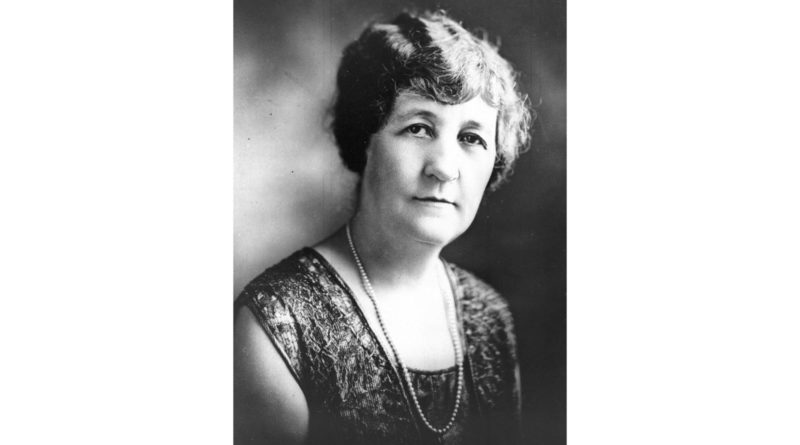Miriam A. ‘Ma’ Ferguson: First Woman Texas Governor Was Born in Salado
By JANNA ZEPP | Public domain photos
 Bell County is home of quite a few “firsts,” and one of them was born in Salado. Miriam Amanda Wallace Ferguson, aka “Ma” Ferguson was one of two American “firsts” as state governors who happened to be women, along with Wyoming’s Nellie Tayloe Ross. Both were elected as governor of their states in 1924, just four years after American women gained the right to vote.
Bell County is home of quite a few “firsts,” and one of them was born in Salado. Miriam Amanda Wallace Ferguson, aka “Ma” Ferguson was one of two American “firsts” as state governors who happened to be women, along with Wyoming’s Nellie Tayloe Ross. Both were elected as governor of their states in 1924, just four years after American women gained the right to vote.
Ferguson attended Salado College and what was then Baylor Female College (now the University of Mary Hardin-Baylor). She married her husband, James, son of a Bell County preacher, on Dec. 31, 1899, likely without any plans to become active in politics.
It was her husband’s alleged penchant for unethical behavior while in office that launched her career. “Pa” was governor of Texas until he was indicted and impeached during his second term, forced to resign and barred from holding further Texas office.
Jim Ferguson had been one of the nation’s strongest opponents of woman suffrage earlier, but actively promoted his wife’s candidacy. He ran his wife’s campaign for governor with the slogan: “Two governors for the price of one” against Judge Felix Robertson, the candidate endorsed by the Ku Klux Klan. The Fergusons beat Robertson and went to the Governor’s Mansion for a third time.
“Fergusonism,” as the Fergusons’ brand of populism was called, remains a controversial subject in Texas. Ferguson herself has been described as a fiscal conservative but also pushed for a state sales tax and corporate income tax. She is often erroneously credited with a quote allegedly referring to bilingualism in Texas schools:
“If English was good enough for Jesus Christ, it ought to be good enough for the children of Texas.”
The phrase did not originate with Ferguson and was often attributed to other public figures as a means of making them look uneducated and bigoted.
As governor, Ferguson tackled some of the tougher issues of the day. Though the Fergusons did not drink, she aligned herself with the “wets” in the battle over prohibition. She opposed the Ku Klux Klan, especially after the abduction, rape and murder of a manager of the Indiana Young People’s Reading Circle, Madge Oberholtzer, by then-National Klan President, D.C. Stephenson. The most significant accomplishment during Ferguson’s first term in office was the enactment of legislation — aimed at the Ku Klux Klan — prohibiting the wearing of masks in public.
In her second term, during the Great Depression, Ferguson backed loans for cotton farmers and “bread bonds” to assist mothers with starving children. Regulation of the oil industry began under her administration, and she proposed a tax on oil to benefit schools and roads.
 Ferguson issued thousands of pardons of prisoners during her two nonconsecutive terms in office, many of them to set free those convicted of violating prohibition laws. Though never proven, rumors persisted that pardons were available in exchange for cash payments to her husband. In 1936, voters passed an amendment to the state constitution stripping the governor of the power to issue pardons and granting that power to a politically independent Texas Board of Pardons and Paroles.
Ferguson issued thousands of pardons of prisoners during her two nonconsecutive terms in office, many of them to set free those convicted of violating prohibition laws. Though never proven, rumors persisted that pardons were available in exchange for cash payments to her husband. In 1936, voters passed an amendment to the state constitution stripping the governor of the power to issue pardons and granting that power to a politically independent Texas Board of Pardons and Paroles.
Rumor also had it that state highway contracts went only to companies that advertised in the Fergusons’ newspaper, The Ferguson Forum. A House committee investigated the rumors, but no charges were ever filed.
It is convenient for some historians to lay the blame of lawlessness in Texas at Ferguson’s feet, but she, alone, was not the sole cause. By the 1930s, the Great Depression caused federal and state governments to cut down on personnel and funding of their organizations including the Texas Rangers. The number of commissioned officers in the law-enforcement agency was reduced to 45, and the only means of transportation afforded to Rangers were free railroad passes, or using their personal horses. After taking office in January 1933, Ferguson discharged all serving Rangers. The force also saw its salaries and funds slashed by the Texas Legislature, and their numbers reduced further to 32 men.
Eventually, rising crime rates in Texas caused the Legislature to review public safety in Texas. Based on the report from a Chicago consulting firm, Griffenhagen and Associates, and on the findings of a subsequent legislative committee, the Texas Legislature opted to merge the Texas Rangers with the License and Weight Division, creating the Texas Department of Public Safety on Aug. 10, 1935. The newly formed department became the new home for the Texas Rangers, The Highway Patrol and the crime laboratory.
In October 1933, Ferguson signed into law Texas House Bill 194, which was instrumental in establishing the University of Houston as a four-year institution.
Except for an unsuccessful bid to replace Gov. W. Lee “Pappy” O’Daniel in 1940, the Fergusons remained retired from political life after 1935. In the 1940 campaign, Ma Ferguson trailed O’Daniel’s principal rival, Ernest O. Thompson of Amarillo, who was Texas Railroad commissioner.
Her husband, James, died of a stroke in 1944. Miriam Ferguson died from congestive heart failure in 1961 at the age of 86. She was buried in the Texas State Cemetery in Austin.
Historians of the past have a tendency to view notable women in rather poor lights based on the narratives of their contemporaries. Ferguson’s legacy is no different. She was accused of being a puppet governor; a front for her husband to remain in charge. But, even allegedly checkered as hers was, she opened the doors for other women to run for higher government offices. She did what she could to help other women and their families, farmers, the state economy, and the public. Ferguson was, willingly or not, a woman who led and left an indelible mark on Texas history.




